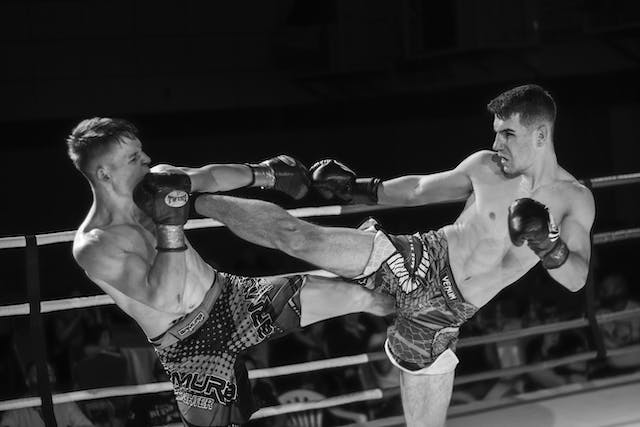Kickboxing is a martial art that incorporates punches, kicks, and knee strikes into one style of combat. Its roots may be found in the prehistoric era, when martial arts were practiced for survival and self-defense. On the other hand, contemporary kickboxing originated in Japan in the 1960s and swiftly expanded to other countries. It is a well-liked sport nowadays that participants of all ages and abilities participate in.
This article will examine the origins of kickboxing, its many forms, its advantages, and the issues that surround the activity. Known as karate boxing, the contemporary style of kickboxing originated in Japan during the 1960s. It was developed by fusing Western-style boxing with traditional karate principles. The sport was first introduced to the United States in the 1970s, but it immediately became popular in Japan. Kickboxing has developed into a multifaceted, international sport with several styles.

Techniques in kickboxing,
Kickboxing comes in a variety of forms, each with its own set of guidelines and methods. The most well-liked forms are K-1, Savate, American Kickboxing, and Muay Thai. Punches, kicks, and knee blows to the head and body are permitted in American Kickboxing. It is renowned for its intense, quick-witted battles. Born in Thailand, muay thai, often called Thai boxing, emphasizes the use of the elbows and knees in addition to punches and kicks. It’s a really demanding and complex sport that takes a lot of fitness and training.
The French kickboxing technique known as “savyate” is centered on the use of kicks and is renowned for its elegant and fluid movements. Japanese kickboxing known as K-1 is renowned for its quick reflexes and forceful fighting style, with an emphasis on knockout power.
Kickboxing is a fantastic kind of workout as well as a sport. It offers a full-body exercise that may strengthen, increase flexibility, and improve cardiovascular health. It may also enhance mood and mental wellness and is a useful stress reliever. Furthermore, kickboxing may impart useful self-defense techniques that boost self-esteem and confidence.
Kickboxing has generated debate despite its numerous advantages. The possibility of harm is one of the most worrisome. Because of the sport’s heavy impact, players may sustain scratches, bruises, fractured bones, or even concussions.
There have also been instances of combatants experiencing long-term health problems such brain damage as a result of frequent head trauma. It is crucial that participants follow the right safety procedures and get the right instruction.
Performance-enhancing drug usage by some kickboxers is another contentious issue in the sport (PEDs). PED use may endanger an athlete’s health and provide them an unfair edge. To preserve the integrity of the sport, regulating authorities and organizations must have strong anti-doping rules and implement them.
To sum up, kickboxing is a well-liked sport with a long history and plenty of advantages. It’s a fantastic kind of training that may enhance both mental and physical health, impart useful self-defense abilities, and provide an exciting and demanding workout. But it’s crucial to be aware of the dangers that come with the sport, such the possibility of injury and PED usage. All people may profit from kickboxing and reduce the associated hazards with the right instruction, safety precautions, and conscientious conduct.
Rewards of Kickboxing
Kickboxing is a martial art that provides psychological and emotional advantages in addition to physical ones. Kickboxing stresses discipline, attention, and tenacity, much as other martial arts do. Goal-setting and goal-achieving are recommended for practitioners, since this may boost their confidence and give them a feeling of success. Kickboxing’s mental and physical difficulties may also aid in lowering stress and enhancing general wellbeing.
Although using kickboxing methods in a real-life scenario is not advised, kickboxing may also be an excellent form of self-defense. Kickboxing teaches skills and tactics that are applicable to self-defense scenarios. Individuals may improve their reflexes, situational awareness, and self-defense skills by participating in kickboxing training.

But since kickboxing is a high-impact activity, there are certain possible hazards involved. Sprains, strains, and fractures are examples of potential injuries. It’s crucial to learn under the guidance of a certified teacher and adhere to safety precautions, such as donning gloves and other protective gear, to reduce the chance of damage.
Kickboxing may result in psychological and emotional stress in addition to physical harm. Because the activity is competitive, there may be pressure to perform, which may result in anxiety and other mental health problems. It is critical that practitioners remain conscious of their emotional and mental health and seek assistance when necessary.
To sum up, kickboxing is a dynamic martial art with many mental, emotional, and physical advantages. Strength and endurance are increased, discipline and self-confidence are fostered, and cardiovascular health is enhanced. To reduce the chance of harm, it is essential to train under the guidance of a certified teacher and adhere to all safety precautions. Kickboxing can be a gratifying and meaningful activity for people of all ages and fitness levels with commitment, attention, and persistence.
Methods, Exercise, and Contests
Kickboxing is a fighting sport that uses knees, feet, and hands for striking techniques. The most often used moves target various parts of the opponent’s body, including as knee strikes, front kicks, roundhouse kicks, jabs, crosses, hooks, uppercuts, and front kicks. Kickboxing combines hitting with evasion, footwork, and defensive techniques include clinching with opponents and blocking and parrying incoming attacks. Kickboxing training include sparring, technical exercises, mental preparation, and physical fitness.
Strength, cardio, and flexibility training are all part of physical conditioning, which aims to increase strength, speed, and endurance. Technique exercises help with muscle memory and accuracy by having you practice strikes and combos on pads, bags, and other equipment.
Kickboxing sparring is an essential part of the training process because it gives fighters a realistic environment in which to practice their techniques and hone their timing, strategy, and defensive abilities. Fighters may acquire mental toughness, concentration, discipline, and a good attitude by mentally preparing. They may picture their objectives and plans and maintain composure under pressure by using visualization and meditation methods.
Professional international events and amateur local tournaments are both possible venues for kickboxing contests. The International Kickboxing Federation (IKF), World Kickboxing Association (WKA), and International Sport Kickboxing Association (ISKA) are just a few of the kickboxing organizations and rule sets that exist. Each has its own set of rules and specifications. Full-contact, semi-contact, and light-contact kickboxing matches are among the events that these organizations authorize and support.
Professional kickboxers are graded according to their performance history and skill level; those who show great talent and accomplishment are given titles and championships. Having attained legendary status in the sport, kickboxers Ernesto Hoost, Ramon Dekkers, Buakaw Banchamek, and Giorgio Petrosyan are among the most well-known figures in history.
Is kickboxing well-known?
Kickboxing is a popular sport in many different nations around the globe. Thailand, Japan, the Netherlands, the United States, Brazil, Russia, and the United Kingdom are among the nations where it is most well-liked. Kickboxing, also known as Muay Thai, is the national sport of Thailand and is practiced and appreciated extensively. The Netherlands is home to several well-known kickboxing gyms and has produced a number of well-known kickboxers. Kickboxing has become more and more popular in the US as a form of physical training and self-defense. It is often practiced in Japan in conjunction with other martial arts like judo and karate.
In some circumstances, kickboxing may be a useful technique for self-defense. In a street brawl or other situation requiring self-defense, the striking skills and movement learned in kickboxing may be helpful in protecting oneself against an assailant. But it’s crucial to remember that kickboxing is a sport and not a martial art used for self-defense.
The main objective in a self-defense scenario is to flee the aggressor and get to safety as soon as you can. Kickboxing methods may be useful in repelling an assailant, but situational awareness, de-escalation, and escape tactics are all important forms of self-defense.

It’s crucial to keep in mind that in a self-defense scenario, anything may happen and things can turn unexpected very fast. Therefore, it’s essential to get the right instruction and practice in a real-world environment while being supervised by a certified teacher.
Is an Olympic kickboxing sport
Kickboxing is not yet recognized as an Olympic sport. There have been efforts to include it into next Olympic Games in spite of this. The International Olympic Committee (IOC) recognizes the International Federation of Muaythai Associations (IFMA) as the governing body of Muay Thai, a form of kickboxing. It’s uncertain, however, whether kickboxing will eventually be included in the Olympic schedule.
Why isn’t kickboxing an Olympic sport?
The Olympics currently do not feature kickboxing for a number of reasons. First of all, there are many different kickboxing styles and disciplines, making it difficult to create uniform guidelines and laws that apply to them all. Second, kickboxing is a combat sport that uses hitting tactics that have the potential to injure competitors, which runs counter to the Olympics’ emphasis on safety.
There are still a number of challenges to be solved before kickboxing is given serious consideration for Olympic participation, despite the efforts of several international organizations to provide uniform regulations and encourage safety precautions in the sport. It’s crucial to remember that the selection process for Olympic sports is a strict one that takes into account a number of variables, including popularity, worldwide participation, and adherence to Olympic ideals like friendship, excellence, and respect. Despite being well-liked around the globe, kickboxing hasn’t yet fulfilled all the requirements to be included in the Olympics. Read more